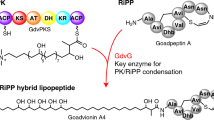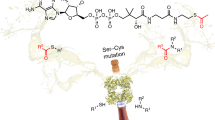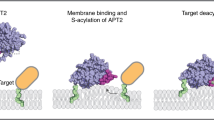Abstract
Acyl-coenzyme A (CoA) ligases catalyze the activation of carboxylic acids via a two-step reaction of adenylation followed by thioesterification. Here, we report the discovery of a non-adenylating acyl-CoA ligase PtmA2 and the functional separation of an acyl-CoA ligase reaction. Both PtmA1 and PtmA2, two acyl-CoA ligases from the biosynthetic pathway of platensimycin and platencin, are necessary for the two steps of CoA activation. Gene inactivation of ptmA1 and ptmA2 resulted in the accumulation of free acid and adenylate intermediates, respectively. Enzymatic and structural characterization of PtmA2 confirmed its ability to only catalyze thioesterification. Structural characterization of PtmA2 revealed it binds both free acid and adenylate substrates and undergoes the established mechanism of domain alternation. Finally, site-directed mutagenesis restored both the adenylation and complete CoA activation reactions. This study challenges the currently accepted paradigm of adenylating enzymes and inspires future investigations on functionally separated acyl-CoA ligases and their ramifications in biology.
This is a preview of subscription content, access via your institution
Access options
Access Nature and 54 other Nature Portfolio journals
Get Nature+, our best-value online-access subscription
$29.99 / 30 days
cancel any time
Subscribe to this journal
Receive 12 print issues and online access
$259.00 per year
only $21.58 per issue
Buy this article
- Purchase on Springer Link
- Instant access to full article PDF
Prices may be subject to local taxes which are calculated during checkout





Similar content being viewed by others
References
Houten, S. M. & Wanders, R. J. A. A general introduction to the biochemistry of mitochondrial fatty acid β-oxidation. J. Inherit. Metab. Dis. 33, 469–477 (2010).
Umbarger, H. E. Amino acid biosynthesis and its regulation. Annu. Rev. Biochem. 47, 532–606 (1978).
Ibba, M. & Soll, D. Aminoacyl-tRNA synthesis. Annu. Rev. Biochem. 69, 617–650 (2000).
Weissman, K. J. The structural biology of biosynthetic megaenzymes. Nat. Chem. Biol. 11, 660–670 (2015).
Hur, G. H., Vickery, C. R. & Burkart, M. D. Explorations of catalytic domains in non-ribosomal peptide synthetase enzymology. Nat. Prod. Rep. 29, 1074–1098 (2012).
Gulick, A. M. Conformational dynamics in the acyl-CoA synthetases, adenylation domains of non-ribosomal peptide synthetases, and firefly luciferase. ACS Chem. Biol. 4, 811–827 (2009).
Schmelz, S. & Naismith, J. H. Adenylate-forming enzymes. Curr. Opin. Struct. Biol. 19, 666–671 (2009).
Estrada, P. et al. The pimeloyl-CoA synthetase BioW defines a new fold for adenylate-forming enzymes. Nat. Chem. Biol. 13, 668–674 (2017).
Wang, M. et al. Using the pimeloyl-CoA synthetase adenylation fold to synthesize fatty acid thioesters. Nat. Chem. Biol. 13, 660–667 (2017).
Marahiel, M. A., Stachelhaus, T. & Mootz, H. D. Modular peptide synthetases involved in nonribosomal peptide synthesis. Chem. Rev. 97, 2651–2674 (1997).
Wu, R., Reger, A. S., Lu, X., Gulick, A. M. & Dunaway-Mariano, D. The mechanism of domain alternation in the acyl-adenylate forming ligase superfamily member 4-chlorobenzoate: coenzyme A ligase. Biochemistry 48, 4115–4125 (2009).
Rudolf, J. D., Dong, L.-B. & Shen, B. Platensimycin and platencin: inspirations for chemistry, biology, enzymology, and medicine. Biochem. Pharmacol. 133, 139–151 (2017).
Dong, L.-B. et al. In vivo instability of platensimycin and platencin: synthesis and biological evaluation of urea- and carbamate-platensimycin. Bioorg. Med. Chem. 25, 1990–1996 (2017).
Rudolf, J. D., Dong, L.-B., Manoogian, K. & Shen, B. Biosynthetic origin of the ether ring in platensimycin. J. Am. Chem. Soc. 138, 16711–16721 (2016).
Smanski, M. J. et al. Dedicated ent-kaurene and ent-atiserene synthases for platensimycin and platencin biosynthesis. Proc. Natl. Acad. Sci. USA 108, 13498–13503 (2011).
Rudolf, J. D., Dong, L.-B., Huang, T. & Shen, B. A genetically amenable platensimycin- and platencin-overproducer as a platform for biosynthetic explorations: a showcase of PtmO4, a long-chain acyl-CoA dehydrogenase. Mol. Biosyst. 11, 2717–2726 (2015).
Smanski, M. J. et al. Expression of the platencin biosynthetic gene cluster in heterologous hosts yielding new platencin congeners. J. Nat. Prod. 75, 2158–2167 (2012).
Hedden, P. & Sponsel, V. A century of gibberellin research. J. Plant Growth Regul. 34, 740–760 (2015).
Altschul, S. F., Gish, W., Miller, W., Myers, E. W. & Lipman, D. J. Basic local alignment search tool. J. Mol. Biol. 215, 403–410 (1990).
Gust, B., Challis, G. L., Fowler, K., Kieser, T. & Chater, K. F. PCR-targeted Streptomyces gene replacement identifies a protein domain needed for biosynthesis of the sesquiterpene soil odor geosmin. Proc. Natl. Acad. Sci. USA 100, 1541–1546 (2003).
Kieser, T., Bibb, M. J., Buttner, M. J., Chater, K. F. & Hopwood, D. A. Practical Streptomyces Genetics (The John Innes Foundation, Norwich, U.K., 2000)..
MacNeil, D. J. et al. Analysis of Streptomyces avermitilis genes required for avermectin biosynthesis utilizing a novel integration vector. Gene 111, 61–68 (1992).
Dong, L.-B., Rudolf, J. D. & Shen, B. Antibacterial sulfur-containing platensimycin and platencin congeners from Streptomyces platensis SB12029. Bioorg. Med. Chem. 24, 6348–6353 (2016).
Herz, W., Kulanthaivel, P. & Watanabe, K. ent-Kauranes and other constituents of three Helianthus species. Phytochemistry 22, 2021–2025 (1983).
Hindra et al. Strain prioritization for natural product discovery by a high-throughput real-time PCR method. J. Nat. Prod. 77, 2296–2303 (2014).
Krissinel, E. & Henrick, K. Inference of macromolecular assemblies from crystalline state. J. Mol. Biol. 372, 774–797 (2007).
Gulick, A. M., Lu, X. & Dunaway-Mariano, D. Crystal structure of 4-chlorobenzoate:CoA ligase/synthetase in the unliganded and aryl substrate-bound states. Biochemistry 43, 8670–8679 (2004).
Osman, K. T., Du, L., He, Y. & Luo, Y. Crystal structure of Bacillus cereus d-alanyl carrier protein ligase (DltA) in complex with ATP. J. Mol. Biol. 388, 345–355 (2009).
Wu, R. et al. Mechanism of 4-chlorobenzoate:coenzyme a ligase catalysis. Biochemistry 47, 8026–8039 (2008).
Horswill, A. R. & Escalante-Semerena, J. C. Characterization of the propionyl-CoA synthetase (PrpE) enzyme of Salmonella enterica: residue Lys592 is required for propionyl-AMP synthesis. Biochemistry 41, 2379–2387 (2002).
Starai, V. J., Celic, I., Cole, R. N., Boeke, J. D. & Escalante-Semerena, J. C. Sir2-dependent activation of acetyl-CoA synthetase by deacetylation of active lysine. Science 298, 2390–2392 (2002).
Schwer, B., Bunkenborg, J., Verdin, R. O., Andersen, J. S. & Verdin, E. Reversible lysine acetylation controls the activity of the mitochondrial enzyme acetyl-CoA synthetase 2. Proc. Natl. Acad. Sci. USA 103, 10224–10229 (2006).
Trivedi, O. A. et al. Enzymic activation and transfer of fatty acids as acyl-adenylates in mycobacteria. Nature 428, 441–445 (2004).
Arora, P. et al. Mechanistic and functional insights into fatty acid activation in Mycobacterium tuberculosis. Nat. Chem. Biol. 5, 166–173 (2009).
Zhang, Z. et al. Structural and functional studies of fatty acyl adenylate ligases from E. coli and L. pneumophila. J. Mol. Biol. 406, 313–324 (2011).
Goyal, A., Verma, P., Anandhakrishnan, M., Gokhale, R. S. & Sankaranarayanan, R. Molecular basis of the functional divergence of fatty acyl-AMP ligase biosynthetic enzymes of Mycobacterium tuberculosis. J. Mol. Biol. 416, 221–238 (2012).
Yonus, H. et al. Crystal structure of DltA. Implications for the reaction mechanism of non-ribosomal peptide synthetase adenylation domains. J. Biol. Chem. 283, 32484–32491 (2008).
Gulick, A. M., Starai, V. J., Horswill, A. R., Homick, K. M. & Escalante-Semerena, J. C. The 1.75 A crystal structure of acetyl-CoA synthetase bound to adenosine-5′-propylphosphate and coenzyme A. Biochemistry 42, 2866–2873 (2003).
Shi, J. et al. Titer improvement and pilot-scale production of platensimycin from Streptomyces platensis SB12026. J. Ind. Microbiol. Biotechnol. 43, 1027–1035 (2016).
Stols, L., Millard, C. S., Dementieva, I. & Donnelly, M. I. Production of selenomethionine-labeled proteins in two-liter plastic bottles for structure determination. J. Struct. Funct. Genomics 5, 95–102 (2004).
Minor, W., Cymborowski, M., Otwinowski, Z. & Chruszcz, M. HKL-3000: the integration of data reduction and structure solution–from diffraction images to an initial model in minutes. Acta Crystallogr. D Biol. Crystallogr. 62, 859–866 (2006).
Terwilliger, T. C. et al. Iterative model building, structure refinement and density modification with the PHENIX AutoBuild wizard. Acta Crystallogr. D Biol. Crystallogr. 64, 61–69 (2008).
Adams, P. D. et al. PHENIX: a comprehensive Python-based system for macromolecular structure solution. Acta Crystallogr. D Biol. Crystallogr. 66, 213–221 (2010).
Vagin, A. & Teplyakov, A. Molecular replacement with MOLREP. Acta Crystallogr. D Biol. Crystallogr. 66, 22–25 (2010).
Winn, M. D. et al. Overview of the CCP4 suite and current developments. Acta Crystallogr. D Biol. Crystallogr. 67, 235–242 (2011).
Chen, V. B. et al. MolProbity: all-atom structure validation for macromolecular crystallography. Acta Crystallogr. D Biol. Crystallogr. 66, 12–21 (2010).
Sievers, F. et al. Fast, scalable generation of high-quality protein multiple sequence alignments using Clustal Omega. Mol. Syst. Biol. 7, 539 (2011).
Tamura, K. et al. MEGA5: molecular evolutionary genetics analysis using maximum likelihood, evolutionary distance, and maximum parsimony methods. Mol. Biol. Evol. 28, 2731–2739 (2011).
Acknowledgements
This work is supported in part by the National Institute of General Medical Sciences Protein Structure Initiative grants GM094585 (A.J.) and GM098248 (G.N.P.) and National Institutes of Health grants GM109456 (G.N.P.) and GM114353 (B.S.). The use of Structural Biology Center beamlines at the Advanced Photon Source was supported by US Department of Energy, Office of Biological and Environmental Research grant DE-AC02-06CH11357 (A.J.). N.W. is supported in part by the Institute of Applied Ecology, Chinese Academy of Sciences, and a scholarship from the Chinese Scholarship Council (201504910034). J.D.R. is supported in part by an Arnold O. Beckman Postdoctoral Fellowship. C.-Y.C. is supported in part by the Fellowship of Academia Sinica–The Scripps Research Institute Postdoctoral Talent Development Program. This is manuscript #29600 from The Scripps Research Institute.
Author information
Authors and Affiliations
Contributions
B.S., G.N.P., and A.J. conceived the project; N.W., J.D.R., L.-B.D., G.N.P. and B.S. designed the experiments; N.W. and J.D.R. performed bioinformatics, molecular cloning, protein production and purification, biochemical analysis, and enzyme reactions; J.D.R. constructed the genetic knockouts in Streptomyces; N.W., J.D.R., and L.-B.D. conducted Streptomyces fermentation; N.W. and L.-B.D. performed natural product isolation and structure determination; C.H.-S. and M.E. performed crystallography; J.O. conducted protein structure determination; N.W., J.D.R., L.-B.D., J.O., C.H.-S., M.E., C.-Y.C., G.B., and B.S. analyzed the results; N.W. and J.D.R. wrote the first draft with input from all co-authors; J.D.R. and B.S. revised and finalized the manuscript.
Corresponding author
Ethics declarations
Competing interests
The authors declare no competing interests.
Additional information
Publisher’s note: Springer Nature remains neutral with regard to jurisdictional claims in published maps and institutional affiliations.
Supplementary information
Supplementary Text and Figures
Supplementary Tables 1–4, Supplementary Figures 1–17
Supplementary Note
Spectroscopic data for diterpenoids 3–10
Rights and permissions
About this article
Cite this article
Wang, N., Rudolf, J.D., Dong, LB. et al. Natural separation of the acyl-CoA ligase reaction results in a non-adenylating enzyme. Nat Chem Biol 14, 730–737 (2018). https://doi.org/10.1038/s41589-018-0061-0
Received:
Accepted:
Published:
Issue Date:
DOI: https://doi.org/10.1038/s41589-018-0061-0
This article is cited by
-
Mapping the biosynthetic pathway of a hybrid polyketide-nonribosomal peptide in a metazoan
Nature Communications (2021)
-
Targeting adenylate-forming enzymes with designed sulfonyladenosine inhibitors
The Journal of Antibiotics (2019)



